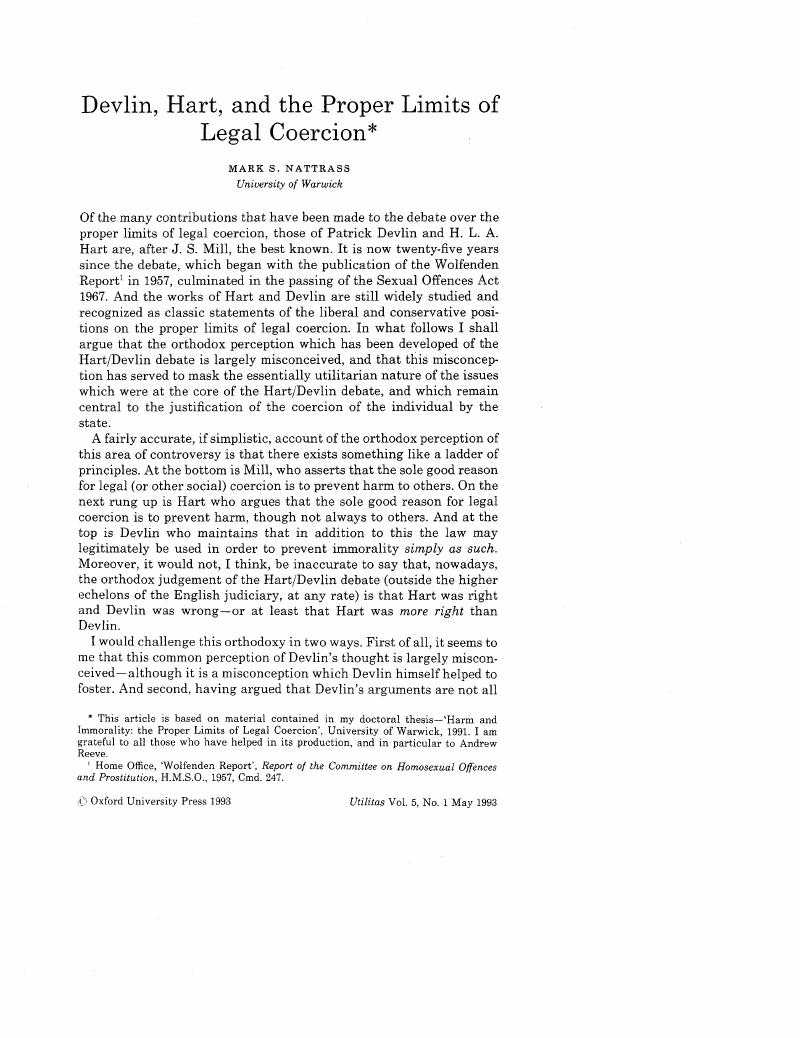No CrossRef data available.
Published online by Cambridge University Press: 26 January 2009

This article is based on material contained in my doctoral thesis—‘Harm and Immorality: the Proper Limits of Legal Coercion’, University of Warwick, 1991. I am grateful to all those who have helped in its production, and in particular to Andrew Reeve.
1 Office, Home, ‘Wolfenden Report’, Report of the Committee on Homosexual Offences and Prostitution, H.M.S.O., 1957, Cmd. 247.Google Scholar
2 Devlin, P., The Enforcement of Morals, London, 1965, p. 2.Google Scholar
3 Ibid., p. 3.
4 Ibid.
5 On this subject see my ‘Arguments for the Legal Coercion of Offensive Actions’, forthcoming in The Journal of Political Philosophy.
6 Hare, R. M., Essays on the Moral Concepts, London, 1972, pp. 97–8.CrossRefGoogle Scholar
7 Dworkin, Ronald, ‘Lord Devlin and the Enforcement of Morals’, Yale Law Review, lxxv (1965–1966), 986.Google Scholar
8 Hart, H. L. A., ‘Social Solidarity and the Enforcement of Morality’, University of Chicago Law Review, xxxv (1967–1968), 1.CrossRefGoogle Scholar
9 I shall not try to demonstrate the presence of this thesis in Devlin's work on this subject. Dworkin perceives such an argument as coming to the fore in his thought after the Maccabaean lecture–i.e. in the later chapters of The Enforcement of Morals.
10 Devlin, , p. 16.Google Scholar
11 Ibid., p. 17.
12 Ibid., p. 19.
13 Dworkin, , ‘Lord Devlin’, p. 992.Google Scholar
14 Devlin, , p. 89.Google Scholar
15 Ibid., pp. 7–8.
16 Ibid., p. viii.
17 Ibid., p. 9. My italics.
18 I have departed from Devlin's original formulation, not only in changing from normative to positive mode, but also in discarding the alternative ‘or are morals always a matter for private judgement’. This clause is not incongruous within the otherwise senseless question which Devlin puts; but seen in the context of the positive version of the question which I have presented it either adds nothing to the first part of the quotation (if it, too, is interpreted positively) or (if interpreted as raising a normative point) it is covered by my version of the second interrogatory.
19 Devlin, , p. 9.Google Scholar
20 Hart, H. L. A., Law, Liberty and Morality, London, 1963, p. 51.Google Scholar
21 This term was coined by Hart in Law, Liberty and Morality, p. 6.Google Scholar
22 Ibid., preface.
23 ‘Wolfenden Report’, para. 13.
24 Devlin, , pp. 11–12.Google Scholar
25 Ibid., pp. 12–13.
26 Particularly in ‘Social Solidarity and the Enforcement of Morality’.
27 Hart, , Law, Liberty and Morality, p. 43.Google Scholar Whether or not the example of bigamy really does show this has been questioned: see Hughes, G., ‘Morals and the Criminal Law’, Yale Law Journal, lxxi (1962), 674Google Scholar; and Mitchell, B., Law, Morality and Religion in a Secular Society, London, 1967, pp. 25–30.Google Scholar
28 Ibid.
29 Ibid., p. 44.
30 Ibid., p. 47.
31 Mitchell, , p. 54.Google Scholar
32 Originally given as an address in 1964, and subsequently included as the final chapter of The Enforcement of Morals.
33 Ibid., p. 133.
34 On the distinction between want- and ideal-regarding conceptions of interest see Barry, Brian, Political Argument, new edn., Hemel Hempstead, 1990.Google Scholar
35 Hart, , Law, Liberty and Morality, preface—my italics.Google Scholar
36 Barry, , p. 43.Google Scholar
37 Barry suggests that Mill's ‘very simple principle’ is a distributive principle—pp. 141–2. He is, I think, quite wrong in this.
38 Packer, H. L., The Limits of the Criminal Sanction, Stanford, 1969, pp. 259–60.Google Scholar
39 As employed by Joel Feinberg in his recent 4-volume work, The Moral Limits of the Criminal Law—see in particular vol. 1, Harm to Others, New York, 1984, ch. 1.1 and ch. 3.1.Google Scholar
40 See Dworkin, Ronald, Taking Rights Seriously, London, 1977.Google Scholar
41 ‘Between Utility and Rights’, Columbia Law Review, lxxix (1979), 828.CrossRefGoogle Scholar Hart acknowledges the appeal of rights, but asserts that a satisfactory passage ‘between the old faith in utilitarianism and the new faith in rights … still awaits discovery’, p. 846.Google Scholar